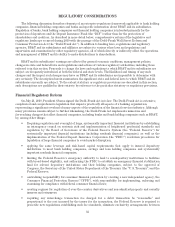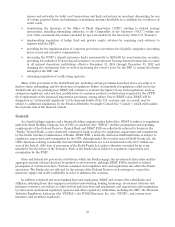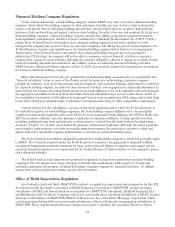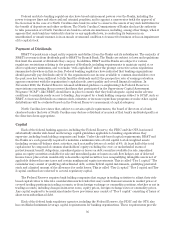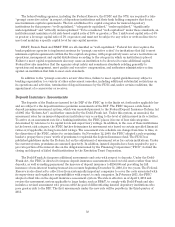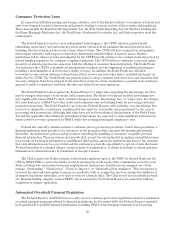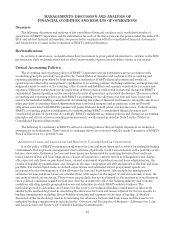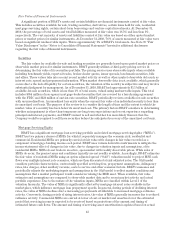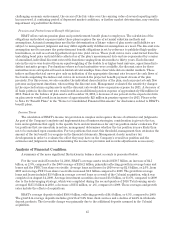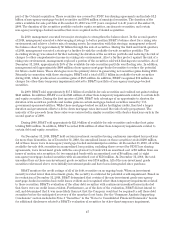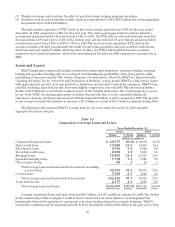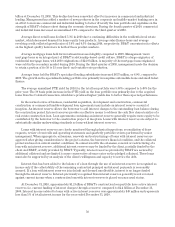BB&T 2010 Annual Report Download - page 40
Download and view the complete annual report
Please find page 40 of the 2010 BB&T annual report below. You can navigate through the pages in the report by either clicking on the pages listed below, or by using the keyword search tool below to find specific information within the annual report.overdrafts on automated teller machine and one-time debit card transactions, unless a consumer consents, or opts
in, to the overdraft service for those types of transactions. The Regulation E amendments also require financial
institutions to provide consumers with a notice that explains the financial institution’s overdraft services,
including the fees associated with the service and the consumer’s choices. BB&T has completed its
implementation of the changes as required by the Regulation E amendments.
In November 2010, the FDIC supplemented the Regulation E amendments by requiring FDIC-supervised
institutions, including Branch Bank, to implement additional changes relating to automated overdraft payment
programs by July 1, 2011. The most significant of these changes require financial institutions to monitor overdraft
payment programs for “excessive or chronic” customer use and undertake “meaningful and effective” follow-up
action with customers that overdraw their accounts more than six times during a rolling 12-month period. The
additional guidance also imposes daily limits on overdraft charges, requires institutions to review and modify
check-clearing procedures, prominently distinguish account balances from available overdraft coverage amounts
and requires increased board and management oversight regarding overdraft payment programs. Branch Bank
has already begun to implement many of the changes required by the FDIC guidance, and is working to
implement others in advance of the July 1, 2011 compliance date.
USA Patriot Act
The USA Patriot Act of 2001 (the “Patriot Act”) contains anti-money laundering measures affecting insured
depository institutions, broker-dealers and certain other financial institutions. The Patriot Act includes the
International Money Laundering Abatement and Financial Anti-Terrorism Act of 2001 (the “IMLAFA”). The
IMLAFA requires such financial institutions to implement policies and procedures to combat money laundering
and the financing of terrorism and grants the Secretary broad authority to establish regulations and to impose
requirements and restrictions on financial institutions’ operations. In addition, the Patriot Act requires the
federal bank regulatory agencies to consider the effectiveness of a financial institution’s anti-money laundering
activities when reviewing bank mergers and bank holding company acquisitions. The Treasury Department has
issued a number of regulations implementing the Patriot Act, which impose obligations on financial institutions to
maintain appropriate policies, procedures and controls to detect, prevent and report money laundering and
terrorist financing. The obligations of financial institutions under the Patriot Act have increased, and may
continue to increase. The increase in obligations of financial institutions has resulted in increased costs for BB&T,
which may continue to rise, and also may subject BB&T to additional liability.
Sarbanes-Oxley Act of 2002
The Sarbanes-Oxley Act of 2002 (the “Sarbanes-Oxley Act”) comprehensively revised the laws affecting
corporate governance, accounting obligations and corporate reporting for companies, such as BB&T, with equity
or debt securities registered under the Securities Exchange Act of 1934, as amended. In particular, the Sarbanes-
Oxley Act established: (1) requirements for audit committees, including independence, expertise, and
responsibilities; (2) certification responsibilities for the Chief Executive Officer and the Chief Financial Officer
with respect to the Company’s financial statements; (3) standards for auditors and regulation of audits;
(4) disclosure and reporting obligations for reporting companies and their directors and executive officers; and
(5) civil and criminal penalties for violation of the federal securities laws.
Future Laws, Regulations and Governmental Programs
Various laws, regulations and governmental programs affecting financial institutions and the financial
industry are from time to time introduced in Congress or otherwise promulgated by regulatory agencies. Such
measures may change the operating environment of BB&T and its subsidiaries in substantial and unpredictable
ways. The nature and extent of future legislative, regulatory or other changes affecting financial institutions is
very unpredictable at this time.
Other Regulatory Matters
BB&T and its subsidiaries and affiliates are subject to numerous examinations by federal and state banking
regulators, as well as the SEC, the FINRA, the NYSE, various taxing authorities and various state insurance
and securities regulators. BB&T and its subsidiaries have from time to time received requests for information
40




